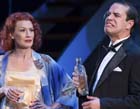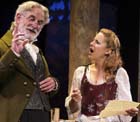‘King John’ offers insight into corruption of power

Be careful what you wish for — and remember that uneasy lies the head that wears a crown.
OK, so that last observation’s from “Henry IV, Part II.”
But it applies equally well to “King John,” a lesser-known — but nonetheless striking — drama that launches the Utah Shakespeare Festival’s ambitious History Cycle, which presents all 10 history plays in chronological order. (Coming in September: “Richard II.”)
Shakespeare’s lone medieval history play, the rarely produced “King John” might not be one for the ages — unlike, say, “Richard III” or “Henry V.”
But it’s still Shakespeare. And it still delivers stirring language, including instantly familiar phrases from “bell, book and candle” to “a twice-told tale.”
To say nothing of keen psychological insight as “King John” unblinkingly depicts the appalling things the powerful do — in the name of power.
In this case, the prize everyone’s after is the English crown, which was contested following the death of Richard I, alias “The Lionheart.”
John (the compelling, mercurial Corey Jones) has claimed the throne — with more than a little help from his mother, the formidable Eleanor of Aquitaine (flinty Jeanne Paulsen).
But Constance (a chillingly anguished Melinda Pfundstein), widow of Henry’s brother Geoffrey, promotes the cause of her young son Arthur (plucky little Bailey W. Duncan), winning the support of the King of France (Fredric Stone).
An arranged marriage creating an alliance between the England and France seems to stave off war — but only until a papal representative (a haughty A. Bryan Humphrey) shows up, stirring up even more trouble.
Our guide for these, and more, machinations: Philip Faulconbridge (the forceful Steve Wojtas), who’s really Lionheart’s illegitimate son — and finds his fervor for King John’s cause tempered not only by the king’s vacillations but the danger such weak leadership poses to England’s safety and strength.
Some judicious trimming of the text helps improve the play’s narrative flow, and director Robynn Rodriguez stages what’s left with clarity and vigor. (Bill Black’s costumes and scenic designer Robert Mark Morgan’s set dressings — red for the English, blue for the French — make it easy to tell where we are, and who’s on whose side.)
Watching these, and more, characters plot their ambitious moves — only to watch those moves blow up in their faces — gives “King John” a curious but undeniable power.
Maybe it’s because it all looks so familiar to us — even after all these centuries.
Contact reporter Carol Cling at ccling@
reviewjournal.com or 702-383-0272.
Review
“King John”
52nd annual Utah Shakespeare Festival
In repertory through Aug. 30
Southern Utah University, Cedar City (2½ hours northeast of Las Vegas on Interstate 15)
$16-$74 (800-752-9849; www.bard.org)
Grade: B+
RELATED STORIES:

‘Peter and the Starcatcher’ captivates at Utah Shakespeare Festival

Song-and-dance numbers make ‘Anything Goes’ entertaining
 Actor brings emotional resonance to ‘The Tempest’
Actor brings emotional resonance to ‘The Tempest’




















